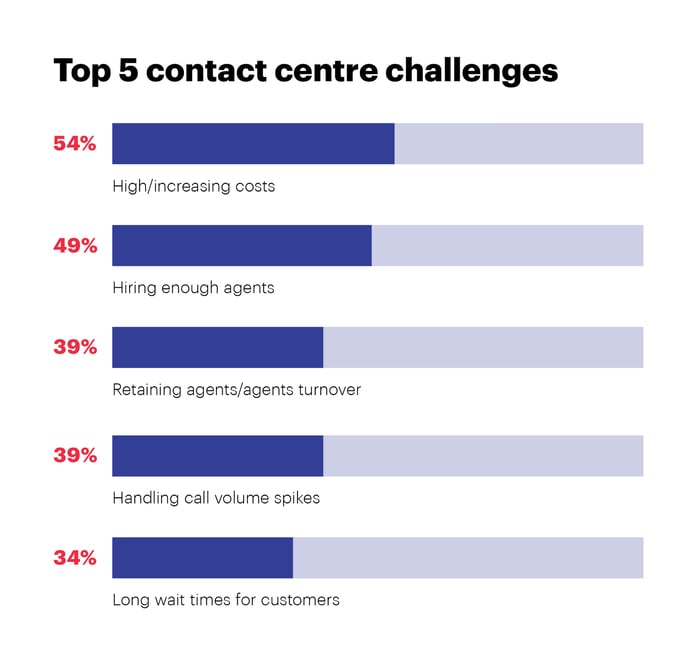Managing a contact centre is a challenge at the best of times, let alone when confronted with a spike in activity due to one of the myriad reasons that encompass the concept of ‘peak demand’. Santa is on his way? Prepare for peak demand. Launching a much-hyped product or promoting a wildly discounted deal? Prepare for peak demand. Confronted with a once-in-a-generation pandemic that forces entire cities into lockdown? React to peak demand.
The ultimate challenge of dealing with peak demand is balancing two key priorities for contact centre managers – reducing the strain on agents while ensuring customers continue to receive the prompt and accurate service they deserve.
Studies have shown that average speed of answer has the highest impact on customer satisfaction scores1 but how do you continue to meet that expectation when demand is surging? Then there is the fact that agents who experience high-stress levels are 19% more likely to leave their jobs2 - and few things are more stressful in the contact centre world than periods of peak demand.
Given such pressures, it is little wonder businesses are rushing to embrace technology that helps ease the load. From intelligent call routing and advance speech recognition to voice verification contact centre managers have a suite of innovative tools and solutions at their disposal to automate, streamline and enhance their processes.
Better still, they now have this handy guide where we will provide five tips for meeting the challenges of peak demand.
-1.jpg?width=800&height=915&name=C_Blog_5%20tips%20for%20dealing%20with%20peak%20demand%20in%20contact%20centres-01%20(1)-1.jpg)

Effective call routing
Planning is an integral part of any peak demand strategy and that includes recruiting additional agents to help manage the workload. While extra bodies will be beneficial, the reality is there will only be so much time to train them and that means they will likely be lower-skilled agents.
This is where call routing technology plays a significant role. Oration’s Intelligent Call Routing uses Advanced Speech Recognition to interpret a caller’s natural language and assign an intent that is then used to direct the call to the best outcome. It is all about getting the right enquiries to the right agents – be it a complex situation to an experienced agent or a run-of-the-mill enquiry to a rookie.
Faster identify verification
One of the best ways for contact centres to reduce average handling time is to reduce the amount of time it takes to verify a caller’s identity. This is especially so for managing peak demand in the lead-up to Christmas or on the back of Black Friday sales as many of the enquiries relate to people wanting to confirm the status of their orders.
Precious seconds count when verifying ID and the likes of Oration’s Identify feature can save them by coupling one or more typical verification questions with optional voice biometrics for added security and improved caller experience. The key is to plan ahead – if you know the rise in demand is coming, ensure you have the technology in place to ease the load.

Source: Conversational AI Statistics: State of Chatbots in 2020 | Landbot
Promote self-service
Times have changed when it comes to self-service. Where customers once yearned to speak with agents, countless studies now show the majority of callers prefer to go it alone. This includes a Harvard Business Review finding that 81% of customers attempt to take care of issues themselves before reaching out to a live agent3.
Deflecting customers to self-service channels not only reduces the load on contact centres but typically allows them to resolve their issues faster than waiting for busy agents to become available. The more specific the deflection, the better as it is essential to ensure the customer does not feel they are being pushed away. Establishing quality self-service options will save time and money, not to mention make seasonal peaks far more manageable.
Targeted banners
Research has found that 96% of customers want to deal with businesses that are responsive to their needs, which is where banner messages can play a vital role in an Interactive Voice Response (IVR) system. The use of speech recognition technology means callers can verbalise their reason for making contact and, in turn, allow the IVR to respond with a targeted banner that can route the caller in a suitable direction (eg: self-service, senior agent). This ability to filter calls by delivering them personalised and highly relevant information will be a blessing when contacts surge during peak periods, not to forget the option to use banners to alert callers when there are delays in the system.
Parcel tracking technology
For the likes of retailers and couriers, peak demand is often at its greatest when customers are eagerly awaiting the arrival of parcels on their doorsteps. The overwhelming desire to know where an item is and when they should expect it to land can prompt even the most patient of souls to pick up the phone and check on its status, creating a huge spike in call volumes during the likes of Christmas and Black Friday sales.
For this reason, many smart operators are implementing parcel tracking technology to allow customers to stay abreast of their orders’ movements and, more importantly, remove their calls from the contact centre queue. For those who do make the call, there is also the chance to use targeted banners to direct them to parcel tracking … and away from the contact centre.
Summary
The business world is competitive enough without failing to deliver during periods of peak demand. Studies show about 65% of customers have changed to a different brand because of a single poor experience4, reinforcing the damage that can arise when contact centres are unable to meet expectations. However, it is also important to remember that the reverse is true – providing quality customer service support during peak seasons or crises can boost customer satisfaction, enhance reputation and grow revenue. By planning ahead and investing in the likes of call routing, speech recognition and self-service technology, contact centres are a step closer to delivering what their customers want and need in the best – and worst – of times.
Deflecting voice calls to a web chat channel service is a great way to navigate the challenge of keeping up with customer enquiry demands. Discover how an Australian supermarket used Oration to save $1.3 million in less than two years across employment, infrastructure and operational costs.





